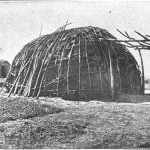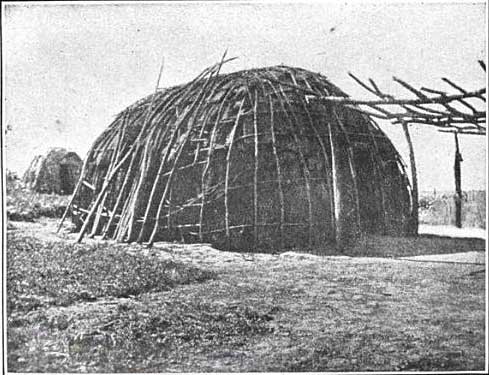On September 15, 1819, the expedition under command of Maj. Stephen H. Long arrived at the mouth of Papillion Creek, on the right bank of the Missouri a few miles above the Platte, a site now covered by the city of Omaha, Nebraska. In the narrative of the expedition it is said that at the mouth of the Papillion ” we found two boats belonging to the Indian traders at St Louis. They had passed us some days before, and were to remain for the winter at the mouth of the Papillion, to trade with the Otoe, Missouri, and other Indians.
“The banks of the Missouri above the Platte, have long been frequented by the Indians, either as places of permanent or occasional residence. Deserted encampments are often seen. On the northeast side, near the mouth of Mosquito river, are the remains of an old Ioway village. Four miles above, on the opposite side, was formerly a village of the Otoe.” 1
As mentioned elsewhere, the Iowa and their kindred tribes had migrated from their ancient habitat in the vicinity of the Great Lakes to the Missouri Valley, and in 1848 a map was prepared by an Iowa Indian showing the route of the tribe from the mouth of Rock River, Illinois, to the banks of the Missouri, across the State which perpetuates the tribal name. The map was reproduced by Schoolcraft. 2
Unfortunately very little is to be found in the early writings regarding the appearance of the Iowa villages, but they probably did not differ from those of the tribes with whom they were so closely associated, and the primitive village, composed of a group of mat or bark covered structures, must have resembled the towns of the Osage. But in addition to the usual habitation the Iowa evidently erected a larger, longer structure. Maximilian on April 25, 1833, when in the region then occupied by the Iowa, wrote: “The canal between Nadaway Island and the cantonment is called Nadaway Slew, at the end of which we saw the remains of some Indian Huts. In a dark glen in the forest, we observed a long Indian hut, which occupied almost its whole breadth, and must have served for a great number of persons.” 3 It is to be regretted that a full description of this “long Indian hut” was not preserved. It may have been a ceremonial lodge rather than a large dwelling.

An interesting though brief account of the Iowa as they were at this time is preserved. It was related by a missionary, Samuel M. Irvin, who arrived among the Iowa April 10, 1837. They were living in the northwestern part of Missouri, the “Platte purchase,” but were soon to be removed to lands west of the Missouri. At that time, the spring of 1837, so the narrative continues: “They numbered in all 830. They were a wild, warlike, roving people, and in a most wretched condition, depending mainly on the chase for a subsistence. Their habitations were of the most frail and temporary kind. They were shelters in the form of huts or houses made of the bark of trees stretched over slender poles and tied together with bark strings, or they were tents or lodges made of the skins of the buffalo or elk, and sewed together with the sinews of these animals. These bark houses were mainly for summer shelter, and would in a few years yield to the wear of time, when they would be abandoned and a new location sought. The skin tents were carried with them, and made their habitations wherever they chanced to stop. They were strictly a migratory and unsettled people.” 4 And “domestic animals, excepting ponies and dogs, were not among them. Indeed, to some of them, such things as cattle, hogs, sheep and poultry were almost unknown, and did such animals happen their way they would pounce upon them for present food as quickly as upon a buffalo or wild turkey.”
An excellent picture of an Iowa habitation accompanied the article from which the preceding quotations have been made and is now reproduced in plate 32b.
Citations:
- James, Edwin, Account of an Expedition from Pittsburgh to the Rocky Mountains, performed in the years 1819 and 1820. Philadelphia, 1823. 2 vols., I, pp. 144-145.[↩]
- Schoolcraft, Henry R., Information Respecting the History, Conditions and Prospects of the Indian Tribes of the United States. Philadelphia, 1851-1857. 6 vols., III, pp. 256-257.[↩]
- Maximilian, Prince Of Wied, Travels in the Interior of North America. London, 1843, p. 124.[↩]
- Plank, Pryor, The Iowa, Sac and Fox Indian Mission. In Transactions of the Kansas State Historical Society, 1907-1908. Vol. X. Topeka, 1908, p. 312.[↩]


